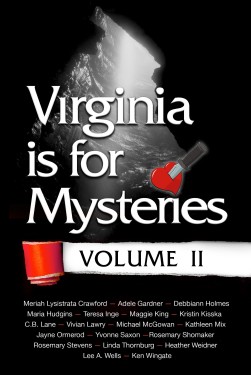Archive
Guest Blog: Virginia is for Mysteries – Volume II

Virginia is for Mysteries blog: http://www.virginiaisformysteries.com/blog/
Virginia is for Mysteries author bios: http://www.virginiaisformysteries.com/authors/
Facebook: https://www.facebook.com/VirginiaIsForMysteries/?ref=br_rs
Twitter: https://twitter.com/VaMysteries?lang=en

Teresa Inge
Teresa Inge grew up in North Carolina reading Nancy Drew mysteries. Today, she doesn’t carry a rod like her idol, but she hot rods. She assists two busy executives and is president of the Sisters in Crime Virginia Beach Chapter. Teresa is the author of “Shopping for Murder,” and “Guide to Murder” in Virginia is for Mysteries, “Fishing for Murder” in the FishNets anthology and has coordinated anthologies. Visit Teresa on Facebook, Twitter, and www.teresainge.com.

Heather Weidner
Heather Weidner has been a mystery fan since Scooby Doo and Nancy Drew. Originally from Virginia Beach, Heather lives in Central Virginia with her husband and pair of crazy Jack Russell terriers. When she’s not reading and writing, she enjoys kayaking, photography, and visiting the beach as much as possible. She is President of the Sisters in Crime, Central Virginia Chapter. Heather’s story “Washed Up” appeared in Virginia is for Mysteries. Her debut novel, Secret Lives and Private Eyes, will be published in May 2016. She writes the blog Crazy for Words and is a guest blogger for a variety of sites. Visit Heather on Facebook, Twitter, Instagram, and Goodreads.
Guest Blogger: Barb Goffman – Before You Hire a Freelance Editor, Read these Tips
Before You Hire a Freelance Editor, Read These Tips
By Barb Goffman
Everyone can always use a second pair of eyes. That’s where I come in.
I’ve been editing fiction for several years as a co-editor of the Chesapeake Crimes anthology series. (Stories in the series have won nearly every major crime-fiction award—check ’em out if you haven’t already.) I’ve been editing nonfiction for far longer than that, thanks to training from the Medill School of Journalism at Northwestern University. (Go Wildcats!) Finally, last year, I decided to hang out my shingle and offer my services on a freelance basis. And I must say I’ve been pleased with the response, both in terms of clients and promotional support from my friends.
My business’s focus is crime fiction. While I could provide a copy edit for any type of fiction (grammar, spelling, and punctuation don’t vary across genres), the genre I’m most familiar with is crime, as it’s what I write. So it’s crime fiction for which I offer developmental editing services, as well as line editing and copy editing.
Having been immersed in it for a while now, allow me to offer my top ten tips for authors planning to use a freelance editor (also known as: how to save yourself a little money and your editor a little gray hair—and yes, that’s gray with an a).
10. The better shape your manuscript is in when I receive it, the less I’ll charge you. So run a spell-check yourself. And pay attention to American spellings. Gray. Toward. Backward. Canceled. Did I mention gray?
9. Real people use contractions when they speak. So use them in your writing, especially your dialogue and internal monologue.
8. Real people also hem and haw when they speak, but, um, well, you don’t, you know, um, have to include all these tics when you write. They can be distracting. A little goes a long way.
7. No one shouts all the time. So lay off using a lot of exclamation points. You can show a person is excited by what he says or by using the occasional “he shouted.” Otherwise, remember that the period is your friend.
6. Put yourself in your characters’ shoes and consider “how would I react?” as your plot moves along. Then put those reactions in your story. When you get too wedded to moving the plot along, you can miss the chance to bring your characters to life by showing their reactions.
to moving the plot along, you can miss the chance to bring your characters to life by showing their reactions.
5. Description is great, but it’s not always appropriate. If your character is entering a place for the first time, it’s believable he’ll look around and notice the architecture and décor. But if he’s coming home after a long day at work to a house he’s lived in for ten years, he’s not going to notice that his house is decorated in a certain style, and he’s not going to focus on the fact that he has four windows in the living room with plantation shutters. At most, he’ll notice that his house smells funny because he forgot to take out the garbage that morning. Again.
4. Always keep your main character’s point of view in mind while you’re writing. If Jane hears a car pulls up outside her house, she can’t know whose car it is unless the car makes a distinctive noise or Jane is looking out the window. (Of course, you could create a character who makes a lot of assumptions, but in that case, I would make use of that. Let Jane wrongly assume it’s John who’s pulled up outside so she flings open the front door, allowing herself to be kidnapped by Sebastian.)
3. Every scene should move the plot along. Character development is wonderful, but you shouldn’t create a scene that only builds character. If your plot isn’t moving forward, your story is stagnant, and the reader may start flipping pages. Don’t do that to yourself.
2. Think through your action scenes to ensure they make sense. I know some writers who once acted out a romance scene. They realized that for the scene to work, one of the characters needed three arms.
1. Create a list of the things you often do that you know you shouldn’t, and go through that list after you type The End. If you tend to overuse a certain word, search for it and change some of them. If you tend to write long, complicated sentences, break some of them up. And please, please, please have someone review your work before you send it out into the world. Someone who’ll tell you the truth—not your mom or your best friend. That’s where I can come in. I’d love to hear from you.
~ ~ ~ ~ ~
Barb Goffman is the author of Don’t Get Mad, Get Even, a collection of short stories published in 2013 by Wildside Press. She won the 2013 Macavity Award for best crime short story published in 2012, and she’s been nominated twelve times for national writing awards—the Agatha (seven times), the Anthony (twice), the Macavity (twice), and the Pushcart Prize once. You can reach her at goffmaneditin[[at]]gmail[[dot]]com . Learn more at http://www.barbgoffman.com and http://www.goffmanediting.com.

